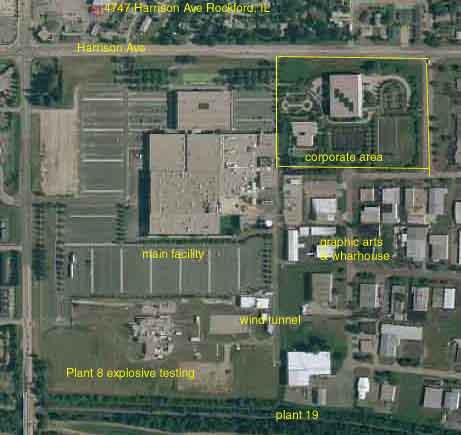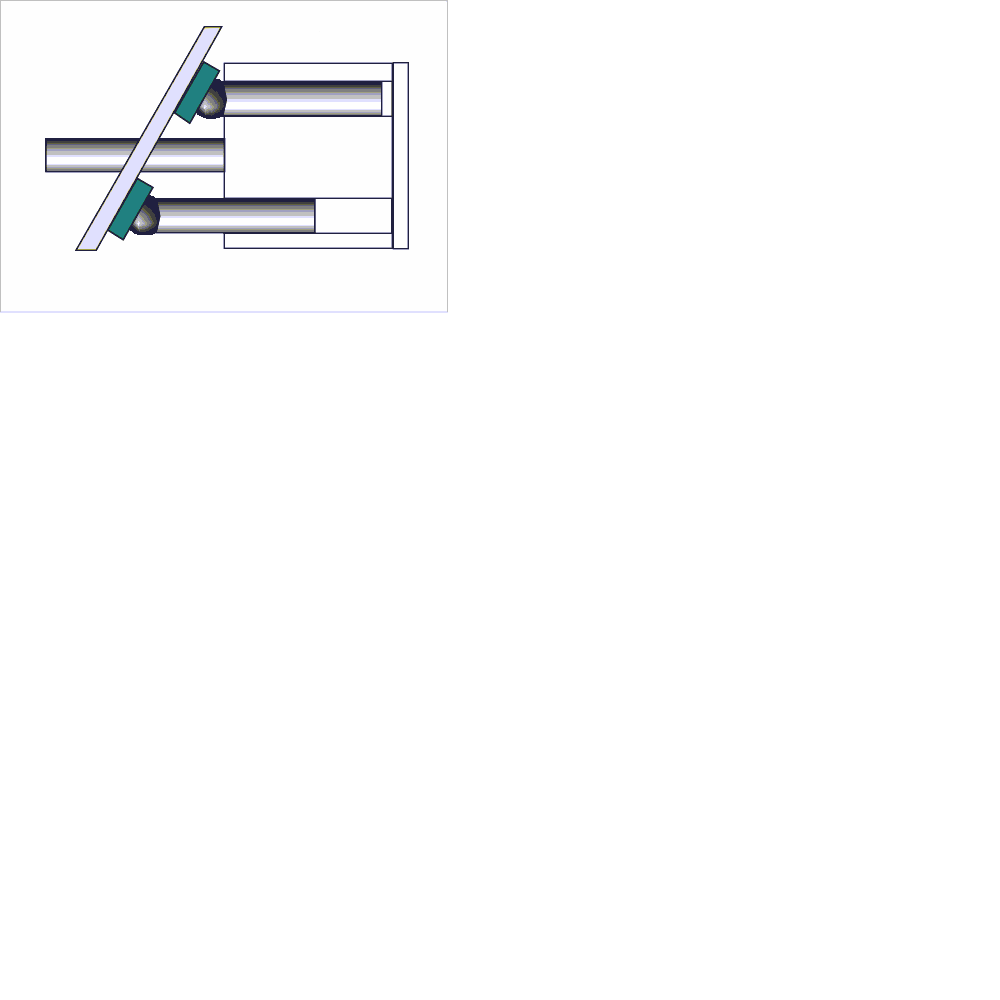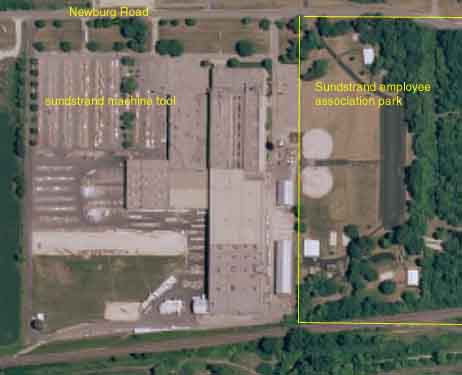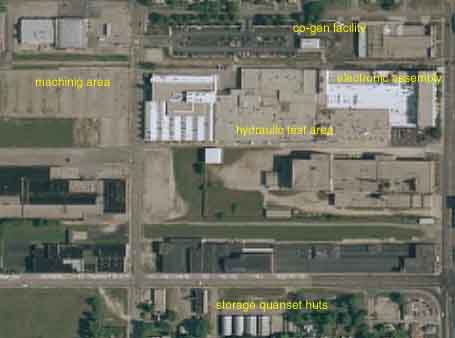|
My Notes on Sundstrand history: This page is never done, I will add content as I can find it, and as
time allows. If you have other information to submit, or find inaccuracies
please send an email to
I continue to work at the Aerospace division located at 4747 Harrison Avenue in Rockford, IL
An overhead shot of what was the corporate Headquarters The building in the upper right hand corner with the Diagonal skylights was the "Corporate Building". It was constructed in 1986 for an estimated cost of around 25 million dollars. It, and the small was recently sold by United Technologies to the Rubloff development group for an estimated 8 million. (What a deal) It takes a real Business acumen on the part of UTC realty to cut a deal like that.
Sundstrand's Bread and butter product is the CSD, and IDG. What are these? The CSD, is a "Constant Speed Drive" You see most aircraft produced from the 50's through the 90's use 3 phase 400hz electric power to run everything. For some reason, the aerospace industry was convinced that this electric power must be as close to 400hz, +/- 2hz or so, and as close to 115VAC +/- a volt or two. Well in order to do that, you have to take the variable speed output from the gas turbine engine that files the plane, put a gearbox on it to reduce the RPM, and hook a generator to it. The CSD is the part that goes between the gearbox, and the generator. It is essentially and automatic transmission that constantly adjusts it output shaft rotation to be 24,000 RPM, regardless of the throttle setting of the engine. The magic part of the CSD is the Axial piston variable displacement pump
This pump has little pistons contained in a revolving cylinder, much like a cylinder of a revolver pistol. The pistons have a "ball head" with a ball socket adapter on top of them. these sit atop a non rotating swash plate. By changing the angle of the swash plate, you change the volume of fluid pumped with each revolution of the cylinder. If you have read the history of Sundstrand part 1, you would have realized that this was invented by Gunnard Wahlmark, and was the pivotal invention that got Sundstrand where it is today. This single pump is the power for hydrostatic transmissions in tractors, skid steer's, and many other industrial componets. This pump launched the Sundstrand hydraulics divisioin, and is the key part that got Sundstrand into the Aerospace bussiness. The IDG is an "Integrated Drive Generator" , and this takes the CSD, and the generator, and puts them in one box. Now this whole system, is a mechanical one, and as electronics started to show up on the scene, separate electronic boxes, were hooked to the Gereantors, to make them hold their voltage regulation better when switching from heavy electrical load to a light electrical load, and also would adjust the CSD to make sure that the frequncy output was as close as possible to 400hz. Sunstrand was now a an electrcal componet supplier, but in order to grow, now had to get more content on the aircraft, well there are the gearboxes that hook up to either the gas turbine engine, or in the early days the piston engine. Also there are other pumps use to pump fuel, or other areas where an electric motor drives a pump to move maybey landing gear, or flight control surfaces. But by and large the electric power was where the money growth was. With all of this electric power being made at the engines, somehow it has to get out to where the need is. So just like your home, the main feed comes in through a single point, goes to a distribution buss inside a circuit breaker panel. The individual circuit breaklers tie onto the "Bus", and take the power to the rooms or places it is needed. An airplane has a similar setup, there is a distribution bus, not just one, but two, one from each generator, on each engine, incase one motor quits, you could hook the whole plane up to the other working engine, and still have power. Sounds simple right? well it's a little more complicated, and the aircraft builders found this out as planes progressed. They wanted a turn key system. Sundstrand stepped forward, and got into the distribution system. This was key for two reasons, First, it lets the system supplier specify his own parts, and secondly it adds more content. This milestone, was most likely the trigger for the construction of the new facility on Harrison Avenue. (I will have to get more info on this from some old timers) The constuction of this facility included a large laboratory to mock up the entire electrical distribution system of an airp I was hired in 1988, Right after Sundstrand had pleaded guilty to "Conspiring to overcharge the Defense Department and scheming to defraud the IRS by taking illegal inventory write-offs." Sundstrand had to pay a $115 million dollar fine. After this news was out, there were a lot of stories about how the executive management would throw lavish parties with carpeted driveways, and skids of fine champagne. Also they would fly their wives around the world on the cooperate jets for shopping junkets. These guys spent the companies money as if it were there own. The sad part was that three innocent schmuck's were accused of this plot, and then the case was dismissed by the judge. No one was ever really caught. Evans W. Erikson was the CEO then, and the board made him retire with a salary, and then moved Harry Stoncipher to the post of CEO. Harry's sidekick was Robert J. Smuland, and he became the president of the division. These two were from GE, and had no other affiliation with Sundstrand. You can say what you will about Evans, but he was an engineer, and had made his way up through the ranks. He had a vision, of what the company should be, and would invest money in it. His philosophy was, that research and development was the key, and also would have the company bid on any job that came along, just to get into the technology, even if it was not a core product. He also spent money on the facility, building the corporate building in 1996, and constant expansion of the main facility. The Machine tool division located on Newburg Road in Belvidere, IL
had been sold, and was not part of Sundstrand when I was hired in 1988.
I am original from Belvidere, and my memories from the late 1970's were
of the labor force on long protracted strikes. I believe then that the
division was suffering from reduced sales due to the foreign competition
for N/C machine tools. The Belvidere Machine tool plant. I think it is now a place for several
small businesses to operate from. When I was last at the Association
park, I seem to remember several pre fab trusses in the parking lot.
I also see some old Sundstrand machine tools being sold on Ebay with
this as an address. Fortunately the Sundstrand association park still
remains for use to the current Hamilton Sundstrand Association members.
I expect it to be taken away at any time |
|
| Back to the USA | page last updated April 19, 2003 |
| Back to History of Sundstrand part1 | |



 This
is the other Sundstrand plant located on 11th street It is the main
"chip cutting" facility for Rockford. In 1999 as part of the
sell out the last remains of the Westinghouse division was move out
to several other Hamilton Standard locations The electronics facility
was then moved in from its location on Kishwaukee avenue.
This
is the other Sundstrand plant located on 11th street It is the main
"chip cutting" facility for Rockford. In 1999 as part of the
sell out the last remains of the Westinghouse division was move out
to several other Hamilton Standard locations The electronics facility
was then moved in from its location on Kishwaukee avenue.